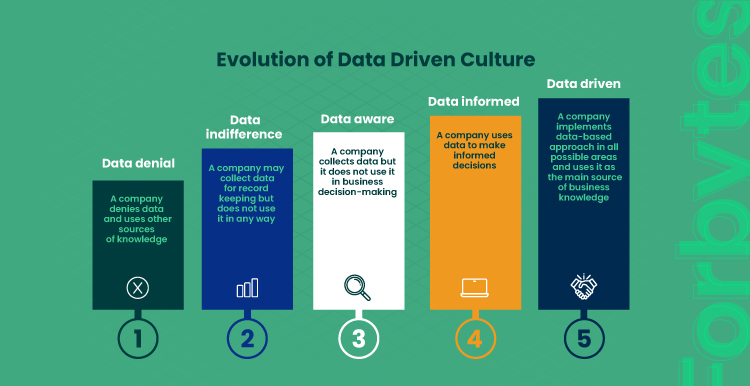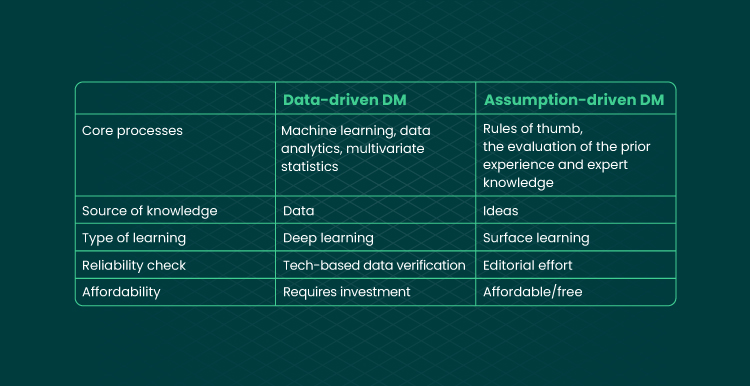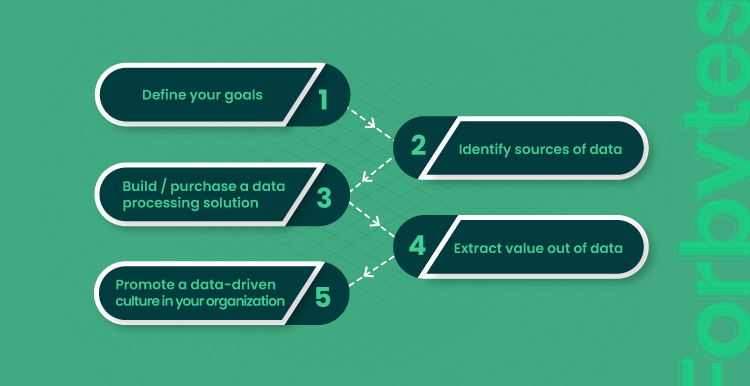Being a businessperson today is not the same as it was 10 years ago. At that time, it was enough to follow someone else’s example of how things should be done. Now, the art of having business acumen has grown to the whole science of managing big data. In this article, we will make it clear how data-driven decision-making is implemented by businesses. We’ll discuss what benefits it gives and how it can change the game.
What Is Data-Driven Decision Making?
Before tech advancement, businesses had no convenient tools for data management. They ran all operations manually and kept documentation in paper folders. Businesses sorted information in alphabetical order to quickly find it if necessary. Sure, the habit of storing data existed even before technology came into the business. But it was stored just for the sake of record keeping. Having data at hand, business leaders felt safe. Yet, the raw data collection process was not insightful and beneficial in any other way.
When technology penetrated the business, everything changed. Companies have automated tools to gather, process, and manage data effectively. Now, we have measurable business objectives, KPIs, and e-commerce metrics on hand. This enables us to set the right direction toward a reliable and safe decision-making process. Today, our competitive advantage and organizational success depend on how well we use data.
In business, every step you take should be goal-oriented. The same goes for gathering data. Apart from just keeping you safe, data has to bring you benefits and influence your decision-making. Data-driven decision-making (DDDM) is when you inform business decisions based on insights from verified data. In DDDM, hard numbers and extracted facts give companies a better understanding of both their business and their clients.
Data-based decision-making enables executives to have an objective look at their business. Their profit is measured by numbers. Similarly, the company’s success and client satisfaction are translated into the language of facts. With data-driven decision-making, business strategy becomes smarter, clearer, and more goal-oriented.
What Is Data-Driven Decision Management?
In marketing, data allows experts to evaluate the effectiveness of advertising campaigns. In content-making, they enable specialists to know what topics raise the most client interest. In sales, data determine what products are in demand and when. In logistics, they help detect the areas of extensive cost spending and the ways to optimize processes. As you see, the list of data applications may be endless.
Data-driven management is a challenging task. According to the NewVantage survey report, almost 99% of executives aim to instill data-driven principles at work. But only 32% manage to do it with DDDM. Why so? Because they aspire to make use of data but forget to consider all the accompanying factors.
If you have the financial capacity to invest in data management, do not hurry up and consider the main aspects. For effective data-driven decisions, you should grow the three core capabilities:
- Find unbiased data sources. Technology does not make mistakes, but humans do. If you provide technology with biased data, the output will also be biased. So, it’s important to know the sources of raw figures and metrics to generate valuable business insights from your data.
- Grow analytical skills. AI-powered data management tools cannot make strategic business decisions but instead humans. ML, Business Intelligence, and AI can do analytics for you. But your executives should have well-developed skills to know how to use the output to accelerate growth.
- Establish a data-driven culture. Your data analyst should share your work philosophy. Data as an asset should be present at every stage of business operations and management. You will have to adjust the processes in your company so that data will be the main indicator of whether things go well.
Data-Driven Process vs Assumption-Driven Process
What does it mean to be data driven? It means to put the data-driven approach at the center of business operations. Here goes the comparison of data-driven and assumption-driven approaches in business.
- Core processes. Data-driven research usually involves the work of many algorithms. These include machine learning, data analytics, multivariate statistics, and more. The assumption-driven method is based on the evaluation of the prior experience. It can also be based on someone else’s case (expert knowledge), and rules of thumb (commonly used methods).
- Source of knowledge. In DDDM, the main source of knowledge is data. You leverage data and manage it with the help of technology. The latter generates analytics that is further presented to humans. Then, the insights are implemented in business processes. As for assumptions, these are based on unsubstantiated ideas. Businesses usually use them as a starting point for business plan development.
- Type of learning. Data-driven approach studies the interconnections between factors. It uses deep learning to detect patterns of how one decision affects another. It enables businesses to configure deep-layer metrics to check how they influence the whole picture. Meantime, surface learning treats a business process as an action/result. It neglects the impact of complementary aspects.
- Reliability check. Tech-powered data verification used in data-driven research eliminates errors. Assumptions, in turn, do not exclude the human factor and rely on the effort of people responsible for data analysis.
- Affordability. DD decisions require investment in custom software development. Or you can pay for the subscription on off-the-shelf tools. Assumption-based decision-making is often experimental and affordable. But it’s also time-consuming, slow, and often inaccurate.
Why Is Data-Driven Decision Making Important?
By 2025, the total volume of generated data worldwide will reach 181 zettabytes (1 zettabyte is equivalent to 1 000 000 000 000 gigabytes). With this happening, the need for AI-driven data management and structuring increases. The main problem of manual data management is that collecting data takes so much time that generating insights from these data becomes pointless before one finishes the process. The thing is, one piece of data is changed to another in real-time, and key insights generated from the outdated data can hardly be effective.
Benefits of Data-Driven Decision Making
If you gather data to make strategic decisions, it brings a lot of practical benefits. Decision-makers may apply data to transform the following aspects of their businesses:
- Optimizing finances. Big data helps companies find gaps in their operations that are cost-consuming. Analyzing the financial performance helps them reach operational efficiency. They also can find ways to streamline the operations.
- Launching new services or products. Data allow businesses to assess product or service demand and invest only in prospective decisions. Analytical tools can forecast trends in the market and predict the changes in consumer preferences and behavior.
- Developing smart strategy. Suppose that you are wondering what location for a store to choose or what personnel investments bring the best returns. Data can fully guide strategic business decisions of this kind. Analytics and numbers help choose the most beneficial and justified path.
- Improving marketing efforts. Data-powered technology helps a marketing specialist draw conclusions about client behavior. This, in turn, allows a marketer specialist to adjust their message to a customer and make it more personalized.
- Upgrading business model. Competitor analysis performed by AI-powered decision-making tools assists businesses in their effort to remain competitive and find new revenue channels. For instance, by analyzing the demand for a subscription to different products or services, businesses may decide whether their target product segment is suitable for this decision.
Below, you may see one of the examples of how data-driven business decisions are used in e-commerce. AI or ML-powered technology collects customer data. The data includes product preferences, the time when clients purchase, their average budget for shopping, etc. These data are stored in the cloud and processed by a data-driven tool. The latter detects patterns that are used in making relevant product recommendations and launching effective marketing campaigns.
Here are the benefits brought by using data to make informed business decisions:
- Consistency in making business decisions. Data-based decision-making makes your strategy more consistent. With clear numbers and patterns, you see how one decision leads to another and can manipulate the metrics to achieve the best results.
- Awareness of the market situation. With data, you get more control over the situation. Your executives are aware of how their work influences the company’s growth. You can set clear goals for your data analysts. It enables your team to launch successful workplace initiatives using AI-driven solutions.
- Positive outcomes of business effort. Businesses no longer need to put their future at stake by investing a significant sum of money into decisions that turn into failure. Data-driven decision-making gives you valuable insights into what outcomes to expect.
- Continual growth. Data-based decisions are aimed at growth. The technology enables you to look at the future before it happens. You can test different approaches, set the connection with your audience, and facilitate decision-making.
- Effortless and transparent accountability. Your employees’ performance translates into data. This adds to the team’s productivity, responsibility, and morale. The cooperation within teams becomes unbiased and goal-oriented.
Examples of Data-Driven Decision Making in Business
Hypothetical benefits are a promising thing. However, each of us wants to see what data-based decision-making is in action. DDDM is implemented by lots of businesses that acknowledge the great potential of AI, Data Science, and ML. Here are a few examples.
Uber
Taxi apps give users great convenience. But for service providers, hiring drivers and connecting them with clients is not enough. On a daily basis, they face the problem of the demand-supply gap where some city locations may be more popular among users than others. They need to distribute cars across the city so that high-demand places get more drivers. To solve this problem and make informed decisions about drivers’ movement across the city, Uber uses data. Car distribution is based on the AI-powered analysis of demand in different locations at different hours. The same goes for pricing. Analyzing the busiest hours, data-driven tools used by Uber adjust the price per ride. This is why the rides during rush hours are usually the most expensive for clients.
Amazon
As said above, data-driven technology makes the customer experience more personalized. This feature is used by ecommerce companies in their effort to engage clients. Amazon also uses data to generate relevant product recommendations. Artificial intelligence can analyze data on what products clients put into their shopping carts. The machine knows what items they have bought on Amazon before. Also, it gathers data on client reviews and pages they visit.
Starbucks
Starbucks applies a data-driven method in making real estate decisions. It uses AI for personalized marketing and menu optimization. Recently, the company was working on the launch of the “k-cups” line and bottled beverages. It integrated the data collected from its stores to understand product demand. The data showed that some clients prefer to order no-sugar drinks. This is why Starbucks decided to include sugar-free K-cups in their grocery line.
It’s no surprise that Google uses data science nearly in all operation spheres. But quite a little is known about how the company promotes data culture inside the team. Recently, Google established a special department responsible for “people analytics.” The department’s function is to use data to explore the effects of management on people. Using a data-driven process, the company has seen how management affects the team’s performance. They got data on the key indicators of successful management. They used the data-driven results in the evaluation of managers to improve their team’s productivity.
Coca-Cola
By 2025, the global digital advertising market is projected to grow to $786 billion. Under the extensive budget, the need for informed marketing decisions doubles. Coca-Cola implements personalized marketing and uses data to learn more about its clients. The company has a big audience on Instagram (2.7 million followers) and Facebook (1.2 million followers). Whenever users tag Coca-Cola on their posts, AI-powered technology analyzes the content, location, time, and products clients choose. In this way, the business learns more about its audience and uses this knowledge when launching marketing campaigns across the globe.
5 Steps Toward Data-Driven Decision Making
If you want to start data-driven decision-making, consider our checklist. We see data-driven process as a 5-step journey that starts with defining what you strive for and ends with cultivating data-driven values in a team.
- Define your goals. Data can satisfy your requests only when they are clearly formulated. Before rushing into technology investments, outline your areas of interest and set clear goals.
- Identify sources of data. These can be real-time data from the web, existing databases, social media, surveys, etc.
- Build/purchase a data processing solution. Find a data engineering company that could help you with this task or purchase an off-the-shelf solution. Yet, the subscription price for such solutions is usually high. A one-time investment in software engineering may be a more reasonable idea.
- Extract value out of data. Encourage your executives to support your data-focused effort. Apply the generated insights to the weak areas of your business. Gradually transform your team’s attitude to decision-making.
- Promote a data-driven culture in your organization. Data should be a justification for your strategic decisions. Turn data analysis into a habit and cultivate a data-based approach to market research. Also remember: a data-driven approach should ally with the company’s mission and has to be ethical.
To sum up, this article comprises everything you should know about using data to make decisions.
If you need help in building your data-driven strategy, our team of consultants, business analysts, and software engineers will gladly help. Just leave us your contact details, and we will get in touch with you soon.

Our Engineers
Can Help
Are you ready to discover all benefits of running a business in the digital era?

Our Engineers
Can Help
Are you ready to discover all benefits of running a business in the digital era?













